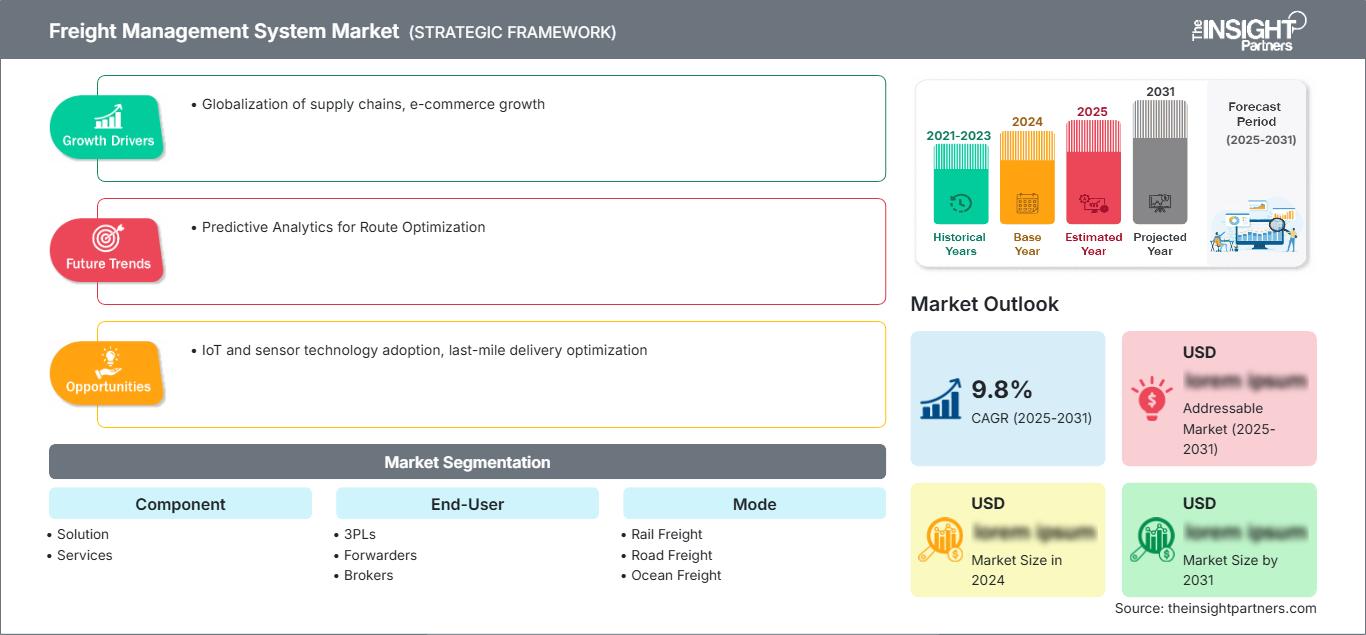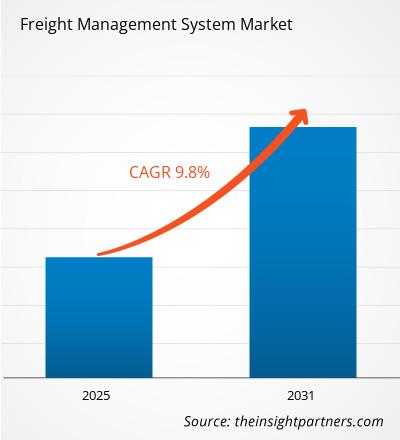화물 관리 시스템 시장은 2023년부터 2031년까지 연평균 성장률(CAGR) 9.8%를 기록할 것으로 예상됩니다. 사물 인터넷(IoT) 및 센서 기술 도입과 최종 배송 최적화는 시장의 주요 트렌드로 남을 것으로 보입니다.
화물 관리 시스템 시장 분석
- 화물 관리 시스템은 GPS, 사물 인터넷(IoT), 증강 현실(AR)과 같은 최신 기술의 등장으로 향후 몇 년 동안 상당한 성장을 보일 것으로 예상됩니다.
- 국제 무역 확대, 실시간 추적 및 데이터 분석은 화물 관리 시스템의 주요 성장 동력입니다. 화물 관리 시스템은 물류 회사에만 국한되지 않고 사업주, 상인, 상인 등도 물류를 간소화하기 위해 사용할 수 있도록 확장될 수 있습니다.
- 클라우드 기반 배포 및 모바일 액세스는 화물 관리 소프트웨어 시장의 주요 트렌드입니다.
화물 관리 시스템 시장 개요
- 화물 관리 시스템 시장은 전 세계적으로 무역량이 급증하고 전자상거래 업계의 신속한 화물 관리 요구가 증가함에 따라 기하급수적으로 성장하고 있습니다. 기업은 실시간 정보를 통해 비용을 절감하고 공급망 중단을 최소화할 수 있습니다.
- AI 통합 및 클라우드 솔루션은 확장성과 더욱 발전된 분석 기능을 제공하는 데 도움이 될 수 있습니다. 또한, COVID-19 발생으로 인해 이러한 변화에 빠르게 적응하여 수많은 기업이 더 빠르고 안정적인 배송 방식을 도입해야 했고, 24시간 연중무휴 가시성을 갖춘 더욱 탄력적인 공급망에 대한 필요성이 커졌습니다.
- 화물 관리 시스템 시장은 매우 안정적인 것으로 입증되었습니다. 구현 비용이 높고 사이버 보안 문제가 있다는 우려가 있지만, 이 글로벌 산업은 향후 6년 동안 다양한 산업과 지역에 걸쳐 꾸준히 성장할 것으로 예상됩니다.
요구 사항에 맞게 이 보고서를 사용자 정의하십시오.
이 보고서의 일부, 국가 수준 분석, Excel 데이터 팩을 포함하여 모든 보고서에 대한 사용자 정의를 무료로 받을 수 있을 뿐만 아니라 스타트업 및 대학을 위한 훌륭한 제안 및 할인을 이용할 수 있습니다
화물 관리 시스템 시장: 전략적 통찰력

- 이 보고서의 주요 주요 시장 동향을 확인하세요.이 무료 샘플에는 시장 동향부터 추정 및 예측에 이르기까지 데이터 분석이 포함됩니다.
화물 관리 시스템 시장 성장 동력 및 기회: 공급망 세계화는 시장에 유리하게 작용할 것
이 보고서의 일부, 국가 수준 분석, Excel 데이터 팩을 포함하여 모든 보고서에 대한 사용자 정의를 무료로 받을 수 있을 뿐만 아니라 스타트업 및 대학을 위한 훌륭한 제안 및 할인을 이용할 수 있습니다
화물 관리 시스템 시장: 전략적 통찰력

- 이 보고서의 주요 주요 시장 동향을 확인하세요.이 무료 샘플에는 시장 동향부터 추정 및 예측에 이르기까지 데이터 분석이 포함됩니다.
- 공급망 세계화는 화물 관리 시스템 시장을 견인하는 또 다른 주요 요인입니다. 생산 및 유통의 복잡성과 규모가 전 세계적 수준에 도달함에 따라 기업들은 제3자 물류(TLS)에 대한 의존도가 높아지고 있습니다.
- 화물 관리 시스템은 실시간 가시성, 국내 및 국제 규제 요건 자동 준수, 경로 최적화 및 비용 절감을 통해 기업이 이러한 과제를 극복하도록 지원합니다.
- 이러한 방식으로 컨테이너화 및 선적 자본 증가로 인한 물류 악몽이 완화되고, 화물 관리를 통해 국경 간 무역의 위험을 줄이고 실시간으로 과제를 해결하면서 비용을 절감할 수 있습니다. 국제 무역에 종사하는 기업들의 경우, 세계화가 공급망을 지속적으로 변화시킴에 따라 공급망 자동화를 확대하려는 움직임이 더욱 커질 것으로 예상됩니다.
경로 최적화를 위한 예측 분석
- 경로 최적화를 위한 예측 분석이 기업의 선적 계획 및 실행 방식에 혁신을 일으키면서 화물 관리 시스템 시장 또한 새로운 기회를 모색하고 있습니다. 빅데이터, 머신 러닝, 실시간 정보를 활용하여 이러한 시스템은 교통량, 날씨, 유류비, 배송 시간대 등의 요소를 고려하여 최적화된 경로를 예측할 수 있으며, 이는 기업에 상당한 이점을 제공할 수 있습니다.
- 예를 들어, 이러한 시스템은 기업이 운송 비용을 절감하고, 배송 시간을 단축하고, 효율성을 향상시킬 수 있도록 지원하여 화물 관리 시스템 시장에 더 많은 기회를 제공합니다. 전자 상거래 및 상품이 여러 중개자를 거쳐 이동하는 공급망 확장과 같은 점점 더 증가하는 추세는 기업이 물류와 관련된 방대한 데이터를 관리하는 데 어려움을 겪고 있습니다.
- 이러한 고급 분석에 대한 수요가 증가함에 따라 이러한 도구는 기업의 의사 결정을 강화하고 운영 효율성을 개선하여 화물 관리 시스템 시장에서 더 많은 기회를 창출하는 획기적인 도구가 될 가능성이 높습니다.
화물 관리 시스템 시장 보고서 세분화 분석
화물 관리 시스템 시장 분석 도출에 기여한 주요 세그먼트는 구성 요소, 최종 사용자 및 모드입니다.
- 구성 요소를 기준으로 화물 관리 시스템 시장은 솔루션과 서비스로 구분됩니다.
- 최종 사용자를 기준으로 화물 관리 시스템 시장은 3PL, 포워더, 브로커, 화주 및 운송업체로 구분됩니다.
- 모드를 기준으로 화물 관리 시스템 시장은 철도 화물, 도로 화물, 해상 화물 및 항공 화물로 구분됩니다. 화물.
지역별 화물 관리 시스템 시장 점유율 분석
- 화물 관리 시스템 시장 보고서는 북미, 유럽, 아시아 태평양(APAC), 중동 및 아프리카(MEA), 중남미를 포함한 5개 주요 지역에 대한 상세 분석으로 구성되어 있으며, 현재 및 과거 시장 규모와 2021년부터 2031년까지의 예측을 포함합니다.
- 각 지역은 국가별로 세분화됩니다. 이 보고서는 18개 이상 국가에 대한 분석 및 예측을 제공하며, 지역 수준에서 시장에 영향을 미치는 동인, 동향 및 기회와 같은 화물 관리 시스템 시장 역학을 다룹니다.
- 또한 이 보고서는 해당 지역의 화물 관리 시스템 시장에 영향을 미치는 주요 요인을 연구하는 PEST 분석도 포함합니다.
화물 관리 시스템 시장
The Insight Partners의 분석가들은 예측 기간 동안 화물 관리 시스템 시장에 영향을 미치는 지역별 동향과 요인들을 면밀히 분석했습니다. 이 섹션에서는 북미, 유럽, 아시아 태평양, 중동 및 아프리카, 그리고 중남미 지역의 화물 관리 시스템 시장 부문 및 지역별 현황도 살펴봅니다.
화물 관리 시스템 시장 보고서 범위
| 보고서 속성 | 세부 |
|---|---|
| 시장 규모 2024 | US$ XX million |
| 시장규모별 2031 | US$ XX Billion |
| 글로벌 CAGR (2025 - 2031) | 9.8% |
| 이전 데이터 | 2021-2023 |
| 예측 기간 | 2025-2031 |
| 다루는 세그먼트 |
By 구성 요소
|
| 포함된 지역 및 국가 | 북미
|
| 시장 선도 기업 및 주요 회사 프로필 |
|
화물 관리 시스템 시장 참여자 밀도: 비즈니스 역학에 미치는 영향 이해
화물 관리 시스템 시장은 소비자 선호도 변화, 기술 발전, 그리고 제품 이점에 대한 인식 제고 등의 요인으로 인한 최종 사용자 수요 증가에 힘입어 빠르게 성장하고 있습니다. 수요가 증가함에 따라 기업들은 제품 및 서비스를 확장하고, 소비자 니즈를 충족하기 위한 혁신을 추진하며, 새로운 트렌드를 적극 활용하고 있으며, 이는 시장 성장을 더욱 가속화하고 있습니다.

- 을 얻으세요 화물 관리 시스템 시장 주요 주요 플레이어 개요
화물 관리 시스템 시장은 1차 및 2차 조사 이후 주요 기업 간행물, 협회 데이터, 데이터베이스 등 정성적 및 정량적 데이터를 수집하여 평가합니다. 화물 관리 시스템 시장의 몇 가지 동향은 다음과 같습니다.
- Oracle은 기업이 글로벌 공급망의 효율성을 높일 수 있도록 Oracle Fusion Cloud Supply Chain & Manufacturing(SCM)에 새로운 물류 기능을 도입했습니다. Oracle Transportation Management와 Oracle Cloud SCM의 일부인 Oracle Global Trade Management에 대한 이번 업데이트는 고객이 가시성을 높이고, 비용을 절감하고, 규정 준수를 자동화하고, 의사 결정을 개선하여 물류 운영을 최적화할 수 있도록 지원합니다. (출처: Oracle, 보도자료, 2024년 2월)
화물 관리 시스템 시장 보고서 범위 및 제공 내용
“화물 관리 시스템 시장 규모 및 예측(2021~2031)” 보고서는 다음 영역을 포괄하는 시장에 대한 자세한 분석을 제공합니다.
- 범위에 포함된 모든 주요 시장 부문에 대한 글로벌, 지역 및 국가 수준의 화물 관리 시스템 시장 규모 및 예측
- 화물 관리 시스템 시장 동향 및 동인, 제약 및 주요 기회와 같은 시장 역학
- 자세한 PEST/포터의 5가지 힘 및 SWOT 분석
- 주요 시장 동향, 글로벌 및 지역 프레임워크, 주요 업체, 규정 및 최근 시장 개발을 포괄하는 화물 관리 시스템 시장 분석
- 시장 집중도, 히트맵 분석, 주요 업체 및 화물 관리 시스템 시장의 최근 개발을 포괄하는 산업 환경 및 경쟁 분석
- 자세한 회사 프로필
- 과거 분석(2년), 기준 연도, CAGR을 포함한 예측(7년)
- PEST 및 SWOT 분석
- 시장 규모 가치/거래량 - 글로벌, 지역, 국가
- 산업 및 경쟁 환경
- Excel 데이터세트
최근 보고서
관련 보고서
사용 후기
구매 이유
- 정보에 기반한 의사 결정
- 시장 역학 이해
- 경쟁 분석
- 고객 인사이트
- 시장 예측
- 위험 완화
- 전략 기획
- 투자 타당성 분석
- 신흥 시장 파악
- 마케팅 전략 강화
- 운영 효율성 향상
- 규제 동향에 발맞춰 대응




















 무료 샘플 받기 - 화물 관리 시스템 시장
무료 샘플 받기 - 화물 관리 시스템 시장